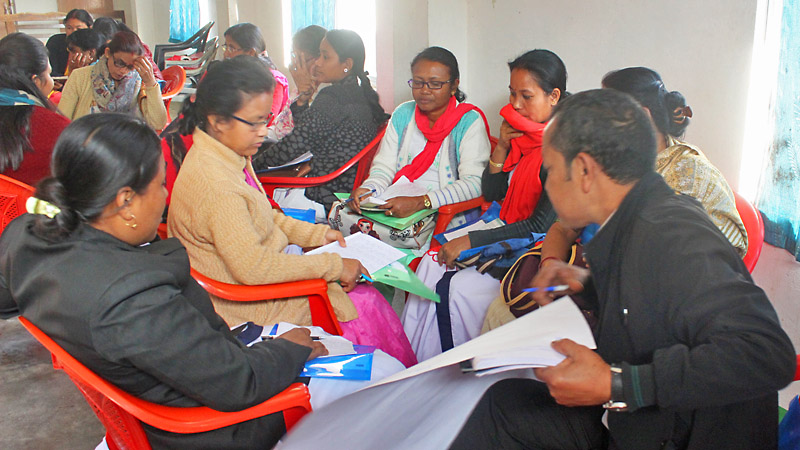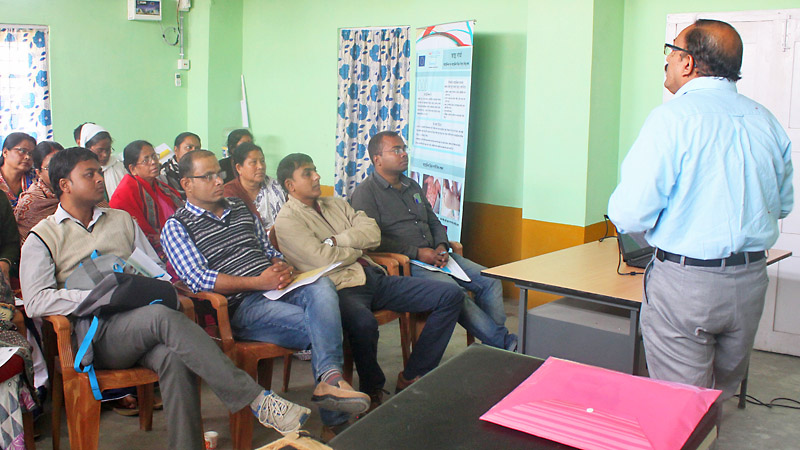Arsenic contamination in sources of drinking water has become a serious cause of concern for human life in Assam, India. The long-term exposure to arsenic, mainly through drinking-water and food, can lead to chronic arsenic poisoning and most characteristically skin lesions and skin cancer.
Within this context there is a growing need for intervention addressing water quality and health perspective for enabling preventive mechanisms for population at risk. According to WHO, the permissible level of arsenic in drinking water is 0.01 mg/l.
In this line of thinking, SaciWATERs conducted a training program and field visit for medical and paramedical practitioners on Prevention, Detection and Management of Arsenicosis in Jorhat and Nalbari, India, on 11–14 February, 2019.
The training and field visit were conducted under the project titled “Civil society voices, vulnerable communities and localised platform for addressing water quality challenges” supported by European Union. The project aims to enable and improve access to safe drinking water and health for marginalised and vulnerable communities in selected arsenic affected areas of India.
The main objectives of the training program and field visit were:
– To build capacity of the medical practitioner and community frontline workers on prevention, detection and management of arsenicosis, and estimate the health burden due to arsenic exposure.
– Identification of manifestation of exposure to arsenic among the community.
– Understanding the community perception on safe water and health, and learning about simple individual level and community led solutions including alternate community owned indigenous means source for accessing safe water.
Dr. Kunal Kanti Majumdar, Arsenic specialist, WHO (SEARO) and Professor, Department of Community Medicine, KPC Medical College & Hospital, Jadavpur, Kolkata, India attended as a resource person of the training program. The participants of the training programs were ASHA, ANM, doctors and community frontline worker.
Dr. Kunal Kanti Majumdar presented about the medical management and identification of health effects of arsenic. It can enter human bodies through water and food. There are many dangers of arsenic poisoning, such as arsenicosis, that can lead to cancer of the lung, blood and skin.
Pregnant women exposed to arsenic are at the risk of having still born children. A person affected by arsenicosis may have melanosis and keratosis. The symptoms ranges from raindrop pigmentation, thickening of skin on palms and feet, chronic cough, weakness, to sores in fingers of hand or feet.
Arsenicosis symptoms are always symmetric (both hands or both feet). If the case is caught early and symptoms are still mild, then the condition can be reversed to some extent. A person can be tested for arsenic poisoning through urine or hair and nails test. Dr. Majumdar also stated that various social stigmas have been associated with arsenicosis. The patients have difficulty in getting married and face social isolation. This causes depression and suicides amongst the patients.
In response to this participants shared their experiences about the water quality problems in their areas. The official from PHED spoke about the measures for promotion safe drinking water in arsenic affected areas and the procedures to test the water in government laboratory.
These training programs would lead to strengthen the capacity of the participants for identification and referral of suspected cases of arsenicosis for proper diagnosis on time and support to conduct health camp in arsenic affected areas. It is also expected that the participants could provide training, as well as generate awareness among community people about the issues of arsenic related health exposure in cascading method.

